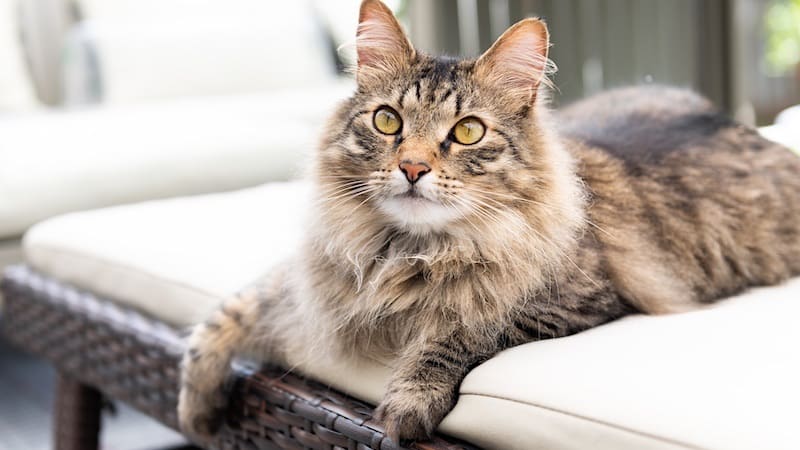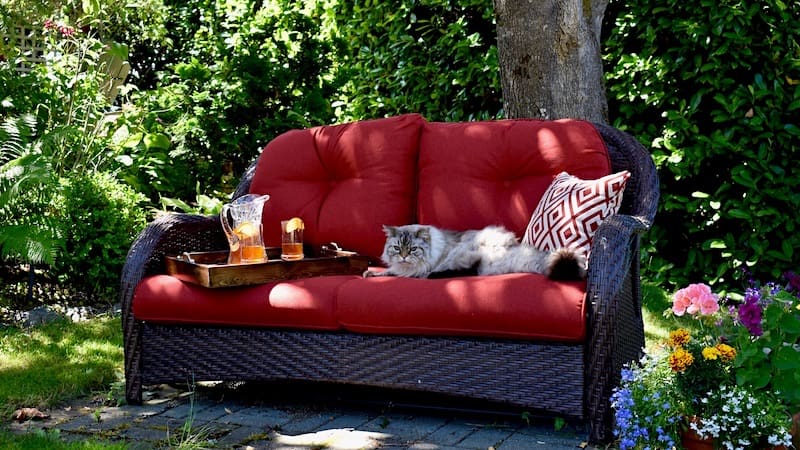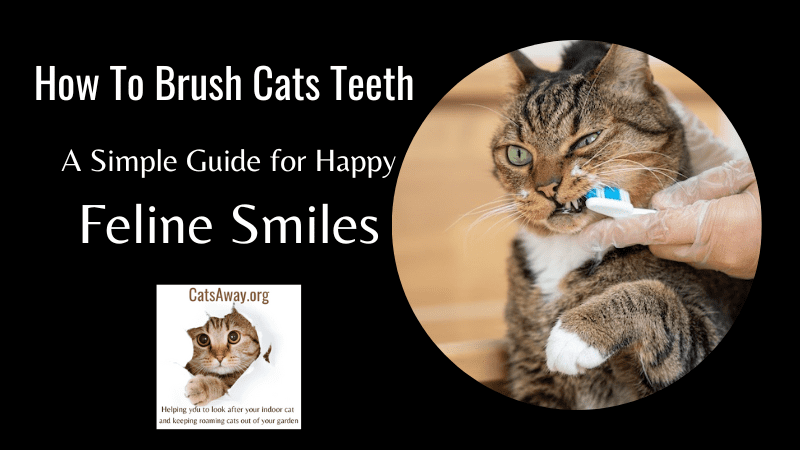Cats can be wonderful companions but they can also be a nuisance, especially for gardeners or for folk who have a patio they like to chill out on. There’s nothing worse than making your coffee and heading out to your patio to catch the morning sun and discovering your favorite chair is covered in cat hair.
Here I’m going to look at how to keep cats off outdoor furniture so that even if you’re a cat lover and own cats yourself, you can still enjoy your favourite garden seat anytime.
How to keep cats off chair cushions

Visual Deterrents
Visual deterrents are a great way to keep cats away from outdoor furniture cushions. Motion-activated sprinklers or lights can be used to startle cats and will soon make them feel uncomfortable visiting the area.
Placing reflective surfaces such as mirrors, aluminum foil, or plastic wrap around your patio area can also help deter cats by making them think another animal is present. Additionally, placing items that move easily with wind such as pinwheels or flags near the outdoor furniture can also help scare off cats.
Physical Deterrents
Physical deterrents are another effective way of keeping cats away from outdoor furniture. Double-sided tape placed on areas where cats like to sit can create an unpleasant sensation when they try to jump onto it and will encourage them not to return.
Plastic sheeting draped over the furniture will prevent cats from jumping up and provide a physical barrier between them and their desired spot. You could also use chicken wire fencing around your garden beds if you have multiple areas where you want to keep out stray animals including cats.
Chemical deterrents
Liquid cat repellent in a spray bottle is one of the most popular methods for keeping neighborhood felines away from outdoor furniture due to their strong scent which repels many animals including felines.
Citrus-based sprays made with lemon juice and/or lime peels, or mix vinegar with water in a spray bottle can be applied directly onto your patio chairs or other pieces of outdoor furniture in order to discourage cats scratching at your outdoor chairs and table legs.
You could also place citrus peels strategically around your garden beds as well since their smell is quite potent and unappealing for many felines.
To effectively deter local and feral cats from your outdoor furniture, it is important to consider a combination of visual, physical and liquid cat repellent. However, if cats are still getting onto your outdoor furniture it may be better to try and stop them getting into your garden altogether so they can’t get anywhere near your patio area.
Recap: Visual, physical and chemical deterrents can be used to keep cats away from outdoor furniture. Visual deterrents include motion-activated sprinklers or lights, reflective surfaces and items that move easily with wind.
Physical deterrents include double-sided tape, plastic sheeting and chicken wire fencing, all of which cats hate to walk or stand on.
Chemical deterrents involve citrus-based sprays made with lemon juice, orange oil or vinegar mixed with water or placing citrus peels strategically around the garden beds.
Keeping Cats Out of Your Garden
Sometimes, if its not your cat that’s the offending critter asking yourself how to keep cats off outdoor furniture is the wrong question and instead you ought to be thinking how you can keep them out of your garden in the first place.
Planting cat-repellent plants is an effective way to keep them out of your garden. These plants have strong odors that they find unpleasant, such as lavender, rue, rosemary, and the Scaredy Cat plant.
Creating barriers around your garden is another great way to deter cats from entering it. Fencing off the area with chicken wire or mesh fencing will help keep them out while still allowing air and sunlight in for your plants.
You can also plant prickly shrubs like holly or barberry to create a physical barrier around the perimeter of your garden.
If you don’t want to install a fence, try a motion activated solar powered cat repeller that uses an ultrasonic sound that will startle any intruding felines away when they are triggered by their movement.
Installing motion-activated sprinklers or lights is an easy and cost effective way cats repellent without having to resort to more extreme measures like trapping them.
The sudden noise and light produced by these devices will scare away any unwanted visitors before they have a chance to do any damage in the yard. Additionally, these devices are weatherproof so they won’t be affected by rain or snowfall, making them ideal for outdoor use all year round.
By implementing a combination of cat-repellent plants, barriers, and motion-activated devices, you can successfully keep cats out of your garden.
Now let’s look at how to care for an indoor cat.
Caring for an Indoor Cat
Cats are naturally curious creatures who enjoy exploring their environment. Providing them with interactive toys such as a scratching post, feather wands or laser pointers can help keep them entertained while also providing mental stimulation.
Additionally, setting up perches near windows so they can watch birds or other animals outside can be a great source of entertainment for cats.
Ideally a catio should be used so they can get plenty of fresh air.
It’s important to feed your cat high-quality food that meets an indoor cats nutritional needs on a daily basis. If you’re unsure what type of food is best for your cat, consult with your veterinarian for advice on which brands are most suitable for their age and health condition.
Scheduling regular veterinary visits and vaccinations is essential for the health of your indoor cat. These checkups should be done at least once a year to ensure that any potential health issues are caught early before they become more serious problems down the road.
Caring for an indoor cat can be a rewarding experience, but it is important to remember that cats are curious creatures and may try to explore their environment.
Ideally, if your indoor cat uses a catio or similar enclosure in the garden you will want to try and deter other neighborhood cats from your garden so your cat isn’t at risk of catching anything from a free roaming pet or feral cat.
Recap: It is important to provide indoor cats with appropriate toys and enrichment activities, adequate nutrition and hydration, as well as regular veterinary visits and vaccinations in order to keep them healthy and happy.
This includes providing interactive toys such as scratching posts or feather wands, setting up perches near windows for entertainment, feeding high-quality food that meets their nutritional needs daily, ensuring fresh water is always available in multiple locations around the house, and scheduling regular checkups with a veterinarian.
Tips for Dealing with Neighbourhood and Stray Cats in Your Yard
There are several steps you can take to discourage a neighbourhood cat from visiting your yard, such as removing potential sources of food and water, keeping lids on garbage cans, and cleaning up any spilled birdseed or pet food.
You should also keep an eye out for stray cats in the area and contact animal control if necessary. Additionally, it’s a good idea to install motion-activated sprinklers or lights around your garden as these will startle any unwanted visitors away without harming them. Also an ultrasonic repellent that only felines can hear is often enough to scare off most intruders.
Seeking Professional Help if Necessary
If none of these methods seem effective at deterring a neighbourhood cat from entering your yard, then it might be time to seek professional help. Animal control officers can provide advice on how best to deal with nuisance animals in your area and they may even be able to trap problem feral cats if necessary.
Recap: There are several steps you can take to discourage local cats from visiting your yard, such as removing potential sources of food and water, keeping lids on garbage cans, and installing motion-activated sprinklers or lights. If none of these methods seem effective, then it might be time to consider commercial humane cat deterrents.
FAQs
What can I spray on my patio furniture to keep cats off?
There are a variety of concoctions you can make to help keep cats off patio furniture. Spraying a mixture of equal parts white vinegar and water on the surface can be an effective deterrent, as cats dislike the smell.
Alternatively, commercial repellents such as citrus-scented sprays or those containing essential oils like eucalyptus or lavender may also work. Finally, placing aluminum foil over sections of your outdoor furniture is another option that cats find unpleasant due to its texture and noise when they walk on it.
What scent keeps cats off furniture?
There are a variety of scents that can help keep cats off furniture. Citrus, lavender, and eucalyptus oils have been known to be effective in deterring cats from furniture. Spraying these essential oils on the area or using them in a diffuser may help repel cats from the desired area.
What can I put on my porch to keep cats off?
There are several ways to keep cats off your porch. Firstly, you can use a motion-activated sprinkler system which will spray water when the cat approaches, deterring them from coming back.
Secondly, you can spread citrus peels or coffee grounds around the perimeter of your porch as cats dislike these smells. Finally, you could try using a repellent such as cayenne pepper or citronella oil which will also help to keep cats away.
By combining all three methods together, it should be possible to successfully deter neighbourhood cats from entering your porch area.
How to get cat hair off outdoor cushions?

Outdoor furniture can be a great addition to any home, but it often comes with one pesky problem – cat hair. Cat hair can get stuck in the fabric of outdoor cushions and make them look unclean. Fortunately, there are several steps you can take to easily remove cat hair from your outdoor cushions.
The first step is to use a lint roller or brush to gently remove any excess fur from the cushions. Once all surface-level hairs have been removed, vacuum the cushion using an attachment that has rubber bristles on it. This will help loosen up any remaining fur that is embedded in the fabric’s fibers.
How to keep cats off your porch at night
If you have a porch, chances are you enjoy spending time there in the evening. When cats take up residence, however, your peaceful outdoor experience can quickly become a noisy one. To keep cats from making your porch their home at night, there are several methods you can try.
First off, start by making sure the area is clean and free of food debris or other items that may attract animals. Keep an eye out for any places cats might be able to hide or rest such as plants or furniture pieces with overhanging fabric.
Try adding some potted plants with strong aromas like lavender or peppermint to help deter cats from setting up shop on your porch. Additionally, place objects like aluminum foil around the perimeter of your porch to make it less appealing for cats that may want to use it as a litter box spot.

Conclusion
Discovering how to keep cats off outdoor furniture can be a challenge. However, with the right mix of deterrents you can have success in deterring neighbourhood cats from your yard.
Remember to use scents that are unpleasant for them such as citrus or mentholated scents to keep them away from patio furniture and other areas of your garden. Additionally, providing an enjoyable environment for any indoor cat will help ensure they don’t feel the need to explore any further than their outdoor catio.
With these tips in mind, you should be able to effectively keep cats off outdoor furniture and out of your garden!
Do you have a problem with neighbourhood cats coming into your garden and scratching or ruining outdoor furniture?
I’ve spend literally hundreds of Dollars on various cat deterrents and tested them over several months, sometimes even years, so you can make the best choices for your particular requirement.
You can discover how the various cat deterrent tests went here.





